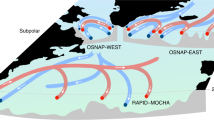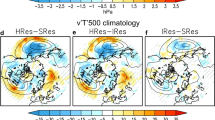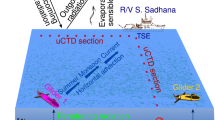Abstract
The characteristics of the North Atlantic jet stream play a key role in the weather and climate of western Europe. Although much of the year-to-year variability in the jet stream arises from internal atmospheric processes that are inherently unpredictable on timescales beyond a few days to weeks, any low-frequency variability or long-term trends that can be considered forced by slowly varying boundary conditions offer the potential for extended range predictability of climatological conditions in western Europe. Here we demonstrate that station-based precipitation observations have displayed pronounced multidecadal variability over the past century in western Europe during the late winter. We then use these precipitation observations as an independent verification of the multidecadal Atlantic jet stream variability found in reanalysis products. Both signals are highly correlated with sea surface temperature variability in the North Atlantic that is well predicted in initialized decadal prediction experiments with a coupled general circulation model. Combining the model-based predictions of the sea surface temperature with the observed relationship between precipitation and sea surface temperature, we show that there is great potential for skilful predictions of the forthcoming decadal average of March precipitation in western Europe, with hindcasts for the UK and Portugal yielding anomaly correlation coefficients of 0.82 and 0.69, respectively.
This is a preview of subscription content, access via your institution
Access options
Access Nature and 54 other Nature Portfolio journals
Get Nature+, our best-value online-access subscription
$29.99 / 30 days
cancel any time
Subscribe to this journal
Receive 12 print issues and online access
$259.00 per year
only $21.58 per issue
Buy this article
- Purchase on Springer Link
- Instant access to full article PDF
Prices may be subject to local taxes which are calculated during checkout




Similar content being viewed by others
Data availability
All data sets used in this study are publicly available. The CESM large ensemble and DPLEs are available through NCAR’s Climate Data Gateway at www.earthsystemgrid.org/. ECMWF reanalyses are available from https://apps.ecmwf.int/datasets/. The CRU TS version 4.01 precipitation data set is available at https://crudata.uea.ac.uk/cru/data/hrg/cru_ts_4.01/, GPCC precipitation is available at https://doi.org/10.5676/DWD_GPCC/FD_M_V2018_050 and ERSSTv5 SSTs are available at https://doi.org/10.7289/V5T72FNM.
Code availability
All analysis codes will be made available from I.R.S. (islas@ucar.edu) on request.
References
Kushnir, Y. Interdecadal variations in North Atlantic sea surface temperature and associated atmospheric conditions. J. Clim. 7, 141–157 (1994).
Trenberth, K. E. & Shea, D. J. Atlantic hurricanes and natural variability in 2005. Geophys, Res, Lett. 33, L12704 (2006).
Frankignoul, C., Gastineau, G. & Kwon, Y.-O. Estimation of the SST response to anthropogenic and external forcing and its impact on the Atlantic multidecadal oscillation and the Pacific decadal oscillation. J. Clim. 30, 9871–9895 (2017).
Clement, A. et al. The Atlantic multidecadal oscillation without a role for ocean circulation. Science 350, 320–324 (2015).
Delworth, T. L. et al. The central role of ocean dynamics in connecting the North Atlantic oscillation to the extratropical component of the Atlantic multidecadal oscillation. J. Clim. 30, 3789–3805 (2017).
Simpson, I. R., Deser, C., McKinnon, K. A. & Barnes, E. A. Modelled and observed multi-decadal variability in the North Atlantic jet stream and its connection to sea surface temperatures. J. Clim. 31, 8313–8338 (2018).
Yeager, S. G. et al. Predicting near-term changes in the Earth system: a large ensemble of initialized decadal prediction simulations using the Community Earth System Model. Bull. Am. Meteorol. Soc. 99, 1867–1886 (2018).
Sutton, R. T. & Dong, B. Atlantic Ocean influence on a shift in European climate in the 1990s. Nat. Geosci. 5, 788–792 (2012).
Dong, B., Sutton, R. T., Woollings, T. & Hodges, K. Variability of the North Atlantic summer storm track: mechanisms and impacts on European climate. Environ. Res. Lett. 8, 034037 (2013).
Dunstone, N. et al. Skilful seasonal predictions of summer European rainfall. Geophys. Res. Lett. 45, 3254–3426 (2018).
Osso, A., Sutton, R., Shaffrey, L. & Dong, B. Observational evidence of European summer weather patterns predictable from spring. Proc. Natl Acad. Sci. USA 115, 59–63 (2018).
Ting, M., Kushnir, Y. & Li, C. North Atlantic multidecadal SST oscillation: external forcing versus internal variability. J. Mar. Syst. 133, 27–38 (2014).
Gastineau, G. & Frankignoul, C. Influence of the North Atlantic SST variability on the atmospheric circulation during the twentieth century. J. Clim. 28, 1396–1416 (2015).
Hodson, D. L. R. et al. Climate impacts of recent multidecadal changes in Atlantic Ocean sea surface temperature: a multimodel comparison. Clim. Dyn. 34, 1041–1058 (2010).
Kushnir, Y. & Held, I. M. Equilibrium atmospheric response to North Atlantic SST anomalies. J. Clim. 9, 1208–1220 (1996).
Davini, P., von Hardenberg, J. & Corti, S. Tropical origin for the impacts of the Atlantic multidecadal variability on the Euro-Atlantic climate. Env. Res. Lett. 10, 094010 (2015).
Omrani, N.-E., Keenlyside, N. S., Bader, J. & Manzini, E. Stratosphere key for wintertime atmospheric response to warm Atlantic decadal conditions. Clim. Dyn. 42, 649–663 (2014).
Peings, Y. & Magnusdottir, G. Forcing of the wintertime atmospheric circulation by the multidecadal fluctuations of the North Atlantic Ocean. Environ. Res. Lett. 9, 034018 (2014).
Peings, Y. & Magnusdottir, G. Wintertime atmospheric response to Atlantic multidecadal variability: effect of stratospheric representation and ocean-atmosphere coupling. Clim. Dyn. 47, 1029–1047 (2016).
Ruprich-Robert, Y. et al. Assessing the climate impacts of the observed Atlantic multidecadal variability using the GFDL CM2.1 and NCAR CESM1 global coupled models. J. Clim. 30, 2785–2810 (2017).
Eade, R. et al. Do seasonal-to-decadal climate predictions underestimate the predictability of the real world? Geophys. Res. Lett. 41, 5620–5628 (2014).
Chang, E. K. M. & Yau, A. M. W. Northern Hemisphere winter storm track trends since 1959 derived from multiple reanalysis datasets. Clim. Dyn. 47, 1435–1454 (2016).
Dell’Aquila, A. et al. Benchmarking Northern Hemisphere midlatitude atmospheric synoptic variability in centennial reanalysis and numerical simulations. Geophys. Res. Lett. 43, 5442–5449 (2016).
Trigo, R. M. & DaCamara, C. C. Circulation weather types and their influence on the precipitation regime in Portugal. Int. J. Climatol. 20, 1559–1581 (2000).
Santos, J. A., Malheiro, A. C., Karremann, M. K. & Pinto, J. G. Statistical modelling of grapevine yield in the Port Wine region under present and future climate conditions. Int. J. Biometeorol. 55, 119–131 (2011).
Poli, P. et al. ERA-20C: an atmospheric reanalysis of the twentieth century. J. Clim. 29, 4083–4097 (2016).
Dee, D. P. et al. The ERA-Interim reanalysis: configuration and performance of the data assimilation system. Q. J. R. Meteorol. Soc. 137, 553–597 (2011).
Sardeshmukh, P. D. & Hoskins, B. J. Spatial smoothing on the sphere. Mon. Weath. Rev. 112, 2524–2529 (1984).
Harris, I., Jones, P. D., Osborn, T. J. & Lister, D. H. Updated high-resolution grids of monthly climatic observations—the CRU TS3.10 dataset. Int. J. Climatol. 34, 623–642 (2014).
Schneider, U., Becker, A., Finger, P., Meyer-Christoffer, A. & Ziese, M. GPCC Full Data Monthly Product Version 2018 at 0.5°: Monthly Land-Surface Precipitation from Rain-Gauges built on GTS-based and Historical Data (Global Precipitation Climatology Centre, 2018); https://doi.org/10.5676/DWD_GPCC/FD_M_V2018_050
Huang, B. et al. Extended reconstructed sea surface temperature, version 5 (ERSSTv5): upgrades, validations, and intercomparisons. J. Clim. 30, 8179–8205 (2017).
Huang, B. et al. NOAA Extended Reconstructed Sea Surface Temperature (ERSST) Version 5 (NOAA, 2017); https://doi.org/10.7289/V5T72FNM
Kay, J. E. et al. The Community Earth System Model (CESM) Large Ensemble Project: a community resource for studying climate change in the presence of internal climate variability. Bull. Amer. Meteor. Soc. 96, 1333–1349 (2015).
Wilks, D. S. ‘The stippling shows statistically significant grid points’, how research results are routinely overstated and overinterpreted and what to do about it. Bull. Am. Meteorol. Soc. 97, 2263–2273 (2016).
Goddard, L. et al. A verification framework for interannual-to-decadal predictions experiments. Clim. Dyn. 40, 245–272 (2013).
Acknowledgements
The CESM project is supported primarily by the National Science Foundation (NSF). This material is based on work supported by the National Center for Atmospheric Research, which is a major facility sponsored by the NSF under Cooperative Agreement no. 1852977. S.G.Y. acknowledges the support of the NSF Collaborative Research EaSM2 Grant OCE-1243015. Computing and data storage resources, which include the Cheyenne supercomputer (https://doi.org/10.5065/D6RX99HX), were provided by the Computational and Information Systems Laboratory (CISL) at NCAR. NOAA_ERSST_v5 data were provided by the NOAA/OAR/ESRL PSD at www.esrl.noaa.gov/psd/. The data analysis was performed with IDL (Excelis Visual Information Solutions).
Author information
Authors and Affiliations
Contributions
I.R.S. conceived the study and conducted the analysis. All the authors contributed to decisions regarding the methodology and contributed to the interpretation of the results. S.G.Y. led the DPLE model experiments used extensively in the analysis. I.R.S. wrote the manuscript with input from all the authors.
Corresponding author
Ethics declarations
Competing interests
The authors declare no competing interests.
Additional information
Publisher’s note: Springer Nature remains neutral with regard to jurisdictional claims in published maps and institutional affiliations.
Supplementary information
Supplementary Information
Supplementary figures and discussions.
Rights and permissions
About this article
Cite this article
Simpson, I.R., Yeager, S.G., McKinnon, K.A. et al. Decadal predictability of late winter precipitation in western Europe through an ocean–jet stream connection. Nat. Geosci. 12, 613–619 (2019). https://doi.org/10.1038/s41561-019-0391-x
Received:
Accepted:
Published:
Issue Date:
DOI: https://doi.org/10.1038/s41561-019-0391-x
This article is cited by
-
Decrease of the spatial variability and local dimension of the Euro-Atlantic eddy-driven jet stream with global warming
Climate Dynamics (2024)
-
Decadal prediction of Northeast Asian winter precipitation with CMIP6 models
Climate Dynamics (2023)
-
A regional (land–ocean) comparison of the seasonal to decadal variability of the Northern Hemisphere jet stream 1871–2011
Climate Dynamics (2022)
-
Seasonally dependent precipitation changes and their driving mechanisms in Southwest Asia
Climatic Change (2022)
-
Projections of northern hemisphere extratropical climate underestimate internal variability and associated uncertainty
Communications Earth & Environment (2021)



